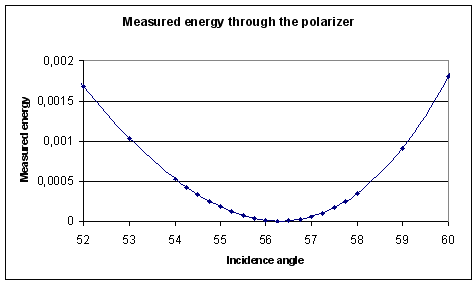Example of Polarizers
Polarizer is an optical component which has a linearizing effect on incoming photons' polarization.
Polarizer and Lens
To obtain a linearly polarized beam, you can consider a collimated light source followed by a polarizer.
_Polarizer_01.png)
To check the light is linearly polarized after the polarizer, you can add a second polarizer which is crossed compared the first one.
As its easy direction is orthogonal to the photon's polarization, it stops all remaining light.
_Polarizer_02.png)
Now a lens can be inserted between both polarizers. Its influence on polarization can be seen by setting an irradiance sensor.
_Polarizer_03.png)
A known figure on the simulation's result can be seen.
_Polarizer_04.png)
Multiple Polarizer
Crossed polarizer (angle between easy axes is 90°) are stopping the light. This next example is a successive polarizer with easy axes angles different from 90°.
Following picture gives the transmission in function of the angle between the easy axis.

In the Polarizer and Lens example, without the lens the light is completely stopped. In this example, you can replace the lens by a polarizer whose easy axis is at 45° from the two others.
The light crossing the first polarizer in linearly polarized at 45° from the second one.
So the second polarizer only stops a part of the light and transmits photons whose polarization is 45° from the last polarizer's easy axis. The last polarizer does not stop all the remaining light. Moreover, the polarization of the light which goes out of the system is orthogonal to the easy axis of the first polarizer. This system acts as a polarization rotation tool. You can achieve a better transmission coefficient by making more rotation steps (here, two 45° steps).
This is basically the way LCDs are rotating the polarization: The molecules in the liquid crystal may be considered as small polarizer and their orientation is evolving along the light path making the polarization rotate progressively reducing losses.
Brewster Angle
Even a simple glass has an influence on polarization. Its optical polished surface behavior on light is described by Fresnel's law. This law is different for S and P polarization.
_Polarizer_S_Polarization.png)
Characteristics:
- First Material: Air (index 1)
- Second Material: BK7 manufactured by SCHOTT (index .513362)
- Brewster angle: 56.54°
- TIR angle: 90.00°
- Wavelength: 689nm
- Polarization: Orthogonal
- Display: Reflection
_Polarizer_P_Polarization.png)
Characteristics:
- First Material: Air (index 1)
- Second Material: BK7 manufactured by SCHOTT (index .513362)
- Brewster angle: 56.54°
- TIR angle: 90.00°
- Wavelength: 689nm
- Polarization: Parallel
- Display: Reflection
We can see on the P polarization curve that there is an angle which only reflects S polarization. As a consequence, for this angle, a reflected beam has same properties as a beam which crossed a polarizer. Its polarization is linear. This angle is called Brewster angle.
_Polarizer_05.png)

We can see the minimum is for the angle value given on the right of the Fresnel curves giving the Brewster angle. It indicates that the reflected polarization is one hundred percent S for this angle.


